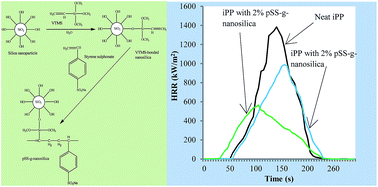Enhanced thermal, mechanical and fire-retarding properties of polystyrene sulphonate-grafted-nanosilica/polypropylene composites
Abstract
Isotactic polypropylene (iPP) nanocomposites have been prepared by melt blending PP with polystyrene sulphonate-grafted-silica nanoparticles (pSS-g-nanosilica) at 190 °C. The weight% of pSS-g-nanosilica was varied from 1 to 5. The unmodified and pSS-g-nanosilica were characterised by transmission electron microscopy, Fourier transform infra-red spectroscopy, X-ray diffraction and UV-vis spectroscopy. The produced nanocomposites were characterised by differential scanning calorimetry, scanning electron microscopy, thermogravimetric analysis, cone calorimetry, limiting oxygen index (LOI) determination and tensile strength analysis. It was found that the modified silica nanoparticles were fully dispersed in the iPP matrix. The maximum increase in tensile strength and melting/crystallisation temperatures were observed at the 2 weight% pSS-g-nanosilica loading, but the fire retardancy increased proportionally with an increase in nanosilica loading in the iPP matrix. The LOI of the nanocomposites was improved from 19.5 to 22, and the peak heat release rate was reduced from 28.49% to 59.13%, depending upon the weight% of pSS-g-nanosilica that was present.


 Please wait while we load your content...
Please wait while we load your content...